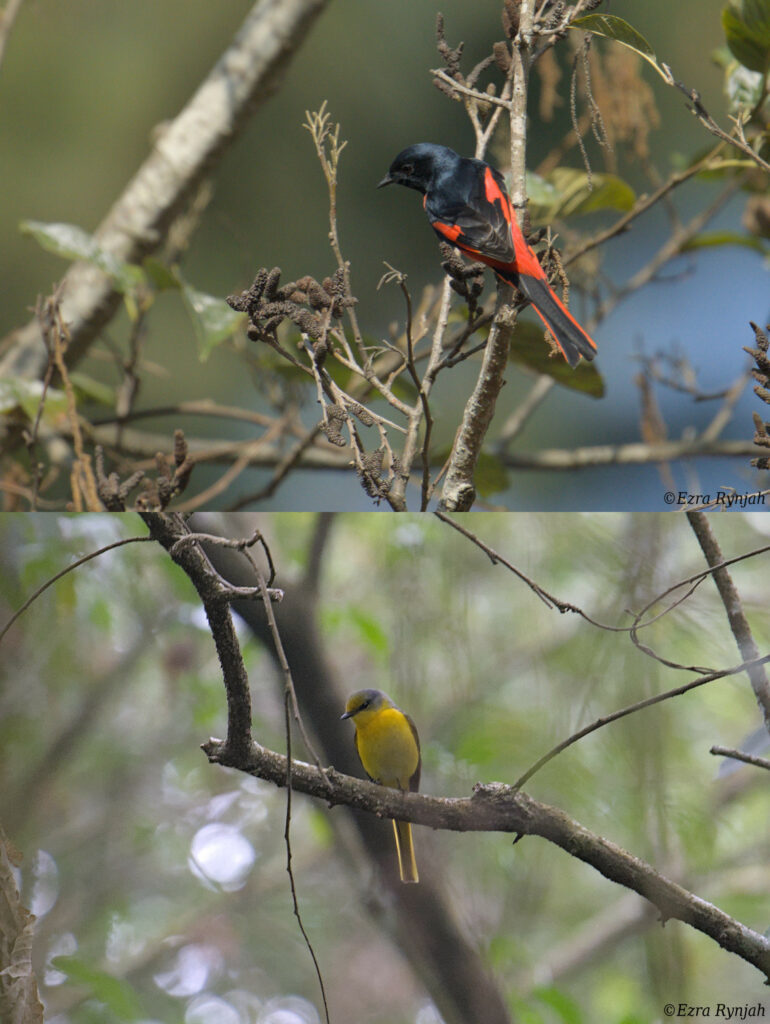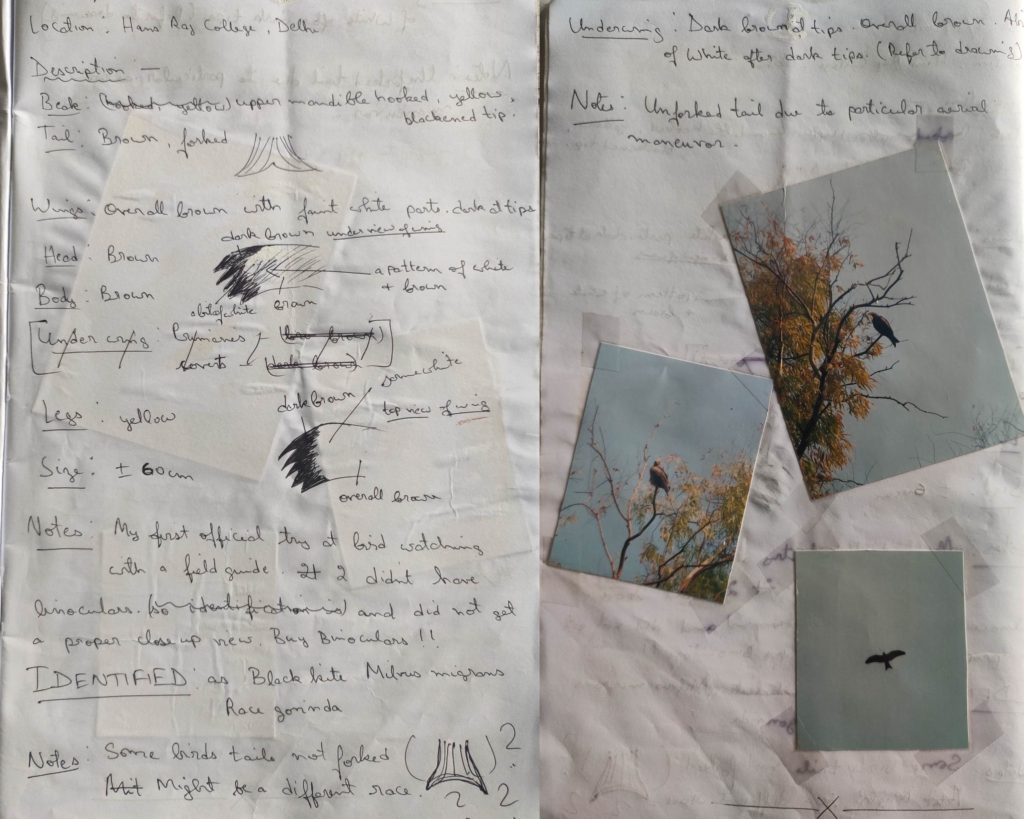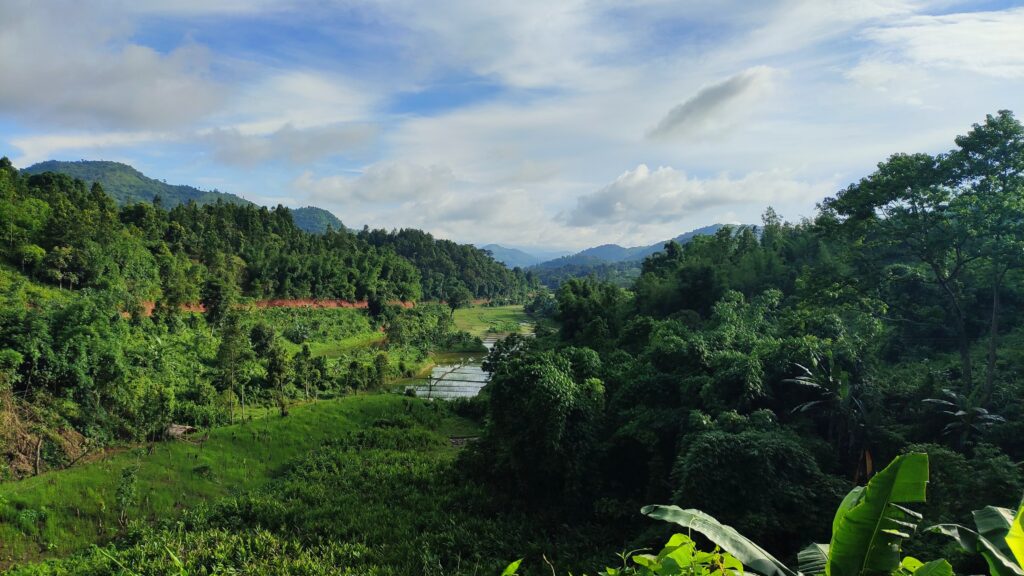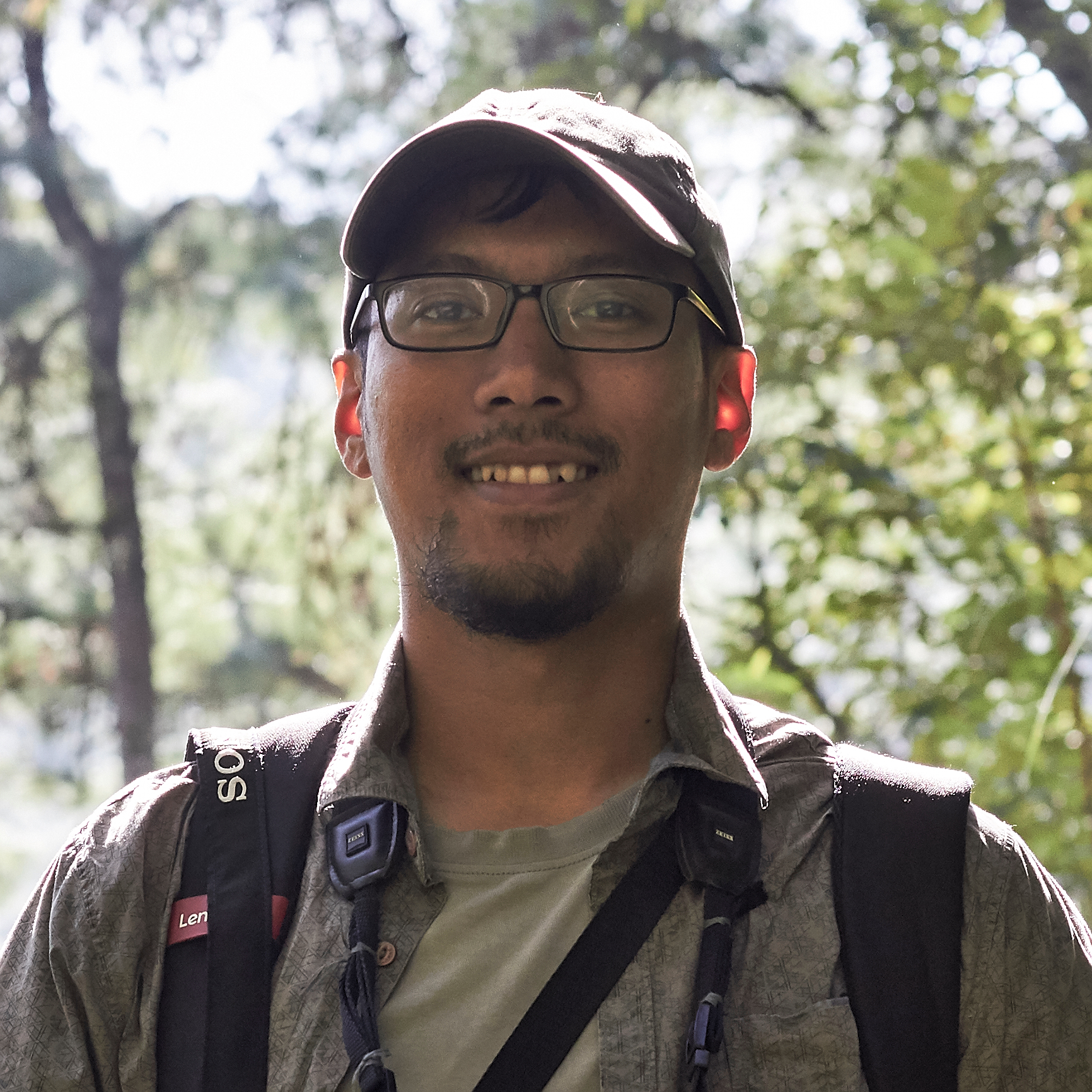A vivid memory of one of my earliest birding experiences was at my farm in Meghalaya. One morning, my cousin and I went to our family farm before sunrise to bird for a couple of hours. It was cloudy and chilly and we had decided to trek through a forest trail going up a hill into a small valley. The trail skirted some hill-rice fields and cut through a patch of pine forest before finally reaching a rivulet, with the pine forest transitioning to a lush broadleaf riparian forest.
We walked slowly up the trail to a hill while trying to identify birds. At the time, I had only just begun birding so I don’t remember many species that we saw along the stretch; I probably didn’t see them well enough. By the time we reached the riparian forest and crossed the rivulet, the sun was out, and the morning had turned pleasant. We decided to climb and rest at a sunny spot overlooking the valley offering a good view of the riparian forest. As we were sitting and idly chatting, there was a sudden flurry of bird activity in the distance and we saw a small swarm of black specks hopping from the canopy of one tree to another, along the course of the rivulet—a mixed species flock! My first conscious experience of encountering one.
The colours of different species shone in the morning sun—bright yellows, striking reds and soothing olive-greens belonging to yellow-cheeked tits, minivets and ashy bulbuls. If memory serves, there was also a black drongo, a leafbird and a couple of warblers. I was transfixed on the spot, captivated by the birds and their colours. Only recently had I gotten a pair of binoculars and every bird that I saw—both common and uncommon—was a visual treat!
Ten years have passed with hundreds of species seen in between; and I still feel captivated by birds and their colours in the very same way.
 A pair of Long-tailed Minivets (Photo: Ezra Rynjah)
A pair of Long-tailed Minivets (Photo: Ezra Rynjah)
This is how my love for birds and nature took shape…
My interest in nature and wildlife started very early in my life. In fact, I can’t seem to recall a time when I was never interested in the natural world. Growing up, I remember being fascinated by books and atlases about the natural world—everything from dinosaurs and wildlife to people who live closely with nature.
I also spent a large part of my childhood outdoors at our family farm where we cultivated rice, seasonal vegetables and kept poultry. As a child, I would occasionally visit the farm with my siblings to spend the day playing and having small outdoor adventures. As I grew older, I regularly accompanied my father to the farm and helped out with some of the work. Once our work was done, I would run off to wander aimlessly and enjoy the surroundings, lost in my own thoughts. On one such occasion, I remember thinking to myself that I could easily spend my life being outdoors without ever getting bored. It was then that I decided that working with wildlife would be the most fun and exciting way to experience the natural world.
I took up a B.Sc. course in Zoology (at Hans Raj College, Delhi) since it was the only path I knew that might lead to a career working with wildlife. During my first year of college, I developed an interest in birds, mostly because they were the only wildlife that was relatively easy to observe where I lived in Meghalaya (large wildlife were either not there or too difficult to spot). Soon after, I bought a copy of Birds of the Indian Subcontinent (by Manakadan, Daniel and Bhopale) from a roadside shop in Delhi, read up whatever I could find on birding and got a pair of binoculars. Luckily, a cousin had also gotten into birding a few years earlier and he taught me the basics to get me started.
 My first attempt at bird identification in Delhi
My first attempt at bird identification in Delhi
When I was in my second year of college, I applied for a summer internship programme to work with wildlife scientists across India. I was fortunate enough to get a two-month internship at the Salim Ali Centre for Ornithology and Natural History (SACON) with Dr. Honnavalli N. Kumara. It was there that I experienced what ‘pursuing research’ means for the first time. As a part of the internship, I conducted a project on the impact of the widespread invasive plant Lantana camara on bulbuls in the landscape surrounding SACON. The project gave me a good insight into field ecology, and I enjoyed every bit of it. I knew then that research was for me. After college, I pursued an M.Sc. in Wildlife Biology and Conservation at the National Centre for Biological Sciences (NCBS) where I was exposed to ecology as a subject, the field methods associated with it and the analytical know-how required to do good research. For my MSc dissertation under the supervision of Dr. Divya Vasudev and Dr. Varun Goswami, I studied forest bird communities in an agricultural landscape in Meghalaya. I explored the effects of vegetation structure and proximity to a protected forest on the different guilds of birds comprising the community.
 An agricultural landscape in Ri-Bhoi District, Meghalaya
An agricultural landscape in Ri-Bhoi District, Meghalaya
After graduating, I spent three years working on mammals but returned to studying birds for my PhD at Deakin University and Conservation Initiatives, under Prof. Don Driscoll, Dr. Vasudev and Dr. Goswami. For my PhD, I studied bird community ecology in agricultural landscapes of Meghalaya. I was looking at how bird communities respond to agricultural-driven forest degradation, based on their forest specialization and functional traits. In addition, I was looking at how assembly processes shaping bird communities were impacted by land use change. To answer these questions, I used a multi-species occupancy modelling framework linked with a functional diversity and trait-based approach. The PhD work was undertaken with the hope of understanding how heterogeneous agricultural landscapes in Meghalaya can be better managed to conserve biodiversity.
I love what I do because..
What I find most enjoyable about my work is, of course, fieldwork—the reason most of us get into this field in the first place. In particular, I really enjoy the experience of walking through a landscape and picking up on its natural history and geography—knowing which bird is calling or which animal a hoof print belongs to, being aware of the vegetation and soil, and understanding the seasonality of the land. The sense of being able to ‘read the land’ is something that I find very fulfilling. Through the course of my work, I have also come to find the process of sitting down with ecological data, analysing it, writing it up and telling its story satisfying.
Challenges I faced..
I’ve been fortunate enough not to have faced any particularly hard challenges over the course of my work. But field ecology can be both mentally strenuous— just as any other academic subject — and physically strenuous when it comes to fieldwork. It can seem very challenging and overwhelming when you’re dealing with everything at once, from writing and submission deadlines, conducting physically taxing fieldwork, to managing other miscellaneous field activities (the list can go on).
During such times, I’ve found that it’s important to work your way through these challenges at a pace that you are comfortable with and that you don’t burn yourself out to the point of losing interest.
My advice for young researchers is..
Firstly, for college students with an interest in ornithology (or ecology in general), always be on the lookout for any opportunities outside of college that would give you hands-on experience in field research. Such opportunities can be more educational than what is taught in college curricula.
Secondly, for young researchers, I would say try to self-teach and don’t wait for a course to be formally offered to learn something new. Nowadays, information is easily available online, and you can keep yourself updated anywhere, anytime. You can learn about trending research topics, field methods and analyses, for example, learning how to use R and the different methods of analysing bird data. There are numerous free materials, tutorials and videos online; don’t hesitate to try them!
Biang La Nam Syiem
[email protected]
Senior Scientist,
Conservation Initiatives, Guwahati, India


This was an amazing read ! And also very inspiring for students like me who are in this field and really passionate about wildlife, nature in general. I’m currently pursuing forestry and I remember ornithology being my favourite subject in the course and scoring highest score in the same .